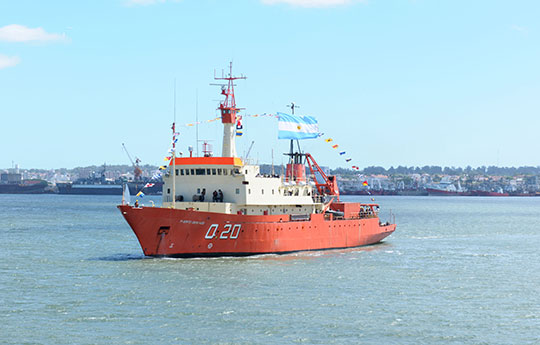OCEANOGRAPHIC CAMPAIGN
The Puerto Deseado Oceanographic Vessel completed the first phase of its campaign
During this stage of the expedition 1,450 specimens of fish from 35 different species were collected.
On February 3rd concluded the first phase of the oceanographic campaign (included in the Annual Antarctic Plan) jointly developed between the National Scientific and Technical Research Council (CONICET), the National Direction of the Antarctic (DNA) and the Argentine Hydrographic Service (SHN). Juan Martín Díaz de Astarloa, senior researcher at CONICET, was the scientific coordinator of this first stage.
During the beginning of the mission, the team performed 24 casts up to 1.000 meters deep and collected 1,450 specimens from 35 species. In some of those cases, researchers must confirm the genetic barcode to identify them.
Then, in the most southern oceanographic station, thirty minutes away from the Antarctic Circle, the team obtained information regarding temperature and salinity for the confirm data from different water masses of the Belingshaussen sea. Specific equipment was used in order to collect physical data.
From that part on, the vessel turned and headed north, crossed the Strait of Bismarck and the Gerlache Channel, places where an intense activity of marine mammals such as the killer whale and other types of whales were glimpsed.
In the Gerlache Strait, although the sea conditions were not good for the use of fishing nets, researchers performed three catches at different depths. Among the specimens collected, there were ice-fish of four different species: zoarcidae (also known as eelpout) liparidae (commonly known as snailfish or seasnails); and a number of invertebrates such as mollusks, ophiuroids, asteroidea, nemertea, sponges, ascidias and more.
By the end of the first phase of the expedition at the Drake Passage, with depths up to 3800 metres, the vessel will return to the city of Ushuaia on February 5th to change the scientific and technical staff. From there, the second part of the mission will start and the team will explore the southern area of the Orcadas islands with Dr. Enrique Marschoff, researcher of the Argentine Antarctic Institute, as a coordinartor.
The Puerto Deseado Oceanographic Vessel of the CONICET and the Comodoro Rivadavia coastal oceanographic Vessel together form the Hydro Oceanographic Research Unit (UNHIDO), which is administered by the CONICET and the Argentine Ministry of Defense.
All the samples collected are going to be part of the biological collections of diverse research institutes such as the Marine and Coastal Research Institute IIMyC-CONICET, the National University of Mar del Plata or the Bernardino Rivadavia Natural Sciences Museum of CONICET and they are the National System of Biological Data conducted by the Ministry of Science, Technology and Productive Innovation of Argentina.
